Enigma (Barcelona, Spain)
Enigma Concept
Carrer de Sepúlveda, 38, 40, L'Eixample, 08015 Barcelona, Spain
+34 932 20 19 74
www.enigmaconcept.es
Mon 10/21/2024, 07:00p-11:05p

On my final day in Barcelona, I finally made my way over to Enigma, no doubt one of the poster children of avant garde Spanish cookery. And why wouldn't it be? The place is the invention of none other than Albert Adrià, of elBulli fame, and represents the closest that we'll likely ever get to a contemporary interpretation of that legendary restaurant in Roses. This was definitely a high priority visit for me.
About the Chef: Albert Adrià Acosta was born in October 1969 in L'Hospitalet de Llobregat, Barcelona, the son of parents Ginés and Josefa. Inspired by his older brother Ferran Adrià, he decided to pursue a career in food in 1985, and began apprenticing at El Bulli, where Ferran was already working. After two years, he committed himself to heading up the pastry department at the restaurant, and during winter closures, he furthered his training at the likes of Pastisseria Turull in Terrassa, Pastisseria Escribà in Barcelona, and Pastelería Totel in Elda, under Francisco Torreblanca. He even staged at Guy Savoy for six weeks, following completion of his military service in 1988. In 1990, El Bulli regained two Michelin stars, which it lost in 1985 following the departure of Jean-Paul Vinay, who initially secured the honor in '83. Three stars arrived in 1997, but it was also during this time when Adrià left the restaurant to write his first book: Los Postres de elBulli, published in October 1998.
Following, he rejoined El Bulli in late '98, this time in the creativity workshop (taller), teaming up with Oriol Castro and eventually taking over the operation altogether. In 2002, El Bulli topped the World's 50 Best Restaurants list for the first time, a feat repeated consecutively from 2006 to 2009. Throughout these years, Adrià also expanded his knowledge by working stints at Bras, The Fat Duck, Mugaritz, Martín Berasategui, and even Charlie Trotter's. In March 2006, he teamed up with childhood friend Juan Martínez to launch the tapas-focused Inopia Classic Bar in Barcelona, and actually ended up leaving El Bulli in 2008. However, the Chef sold his stake in Inopia in July 2010, and it would eventually turn into Lolita Tapería.
Adrià instead decided to link up with the Iglesias brothers (Juan Carlos, Borja, and Pedro, of Rías de Galicia) as well as Ferran to start a series of restaurants in the Sant Antoni neighborhood under the elBarri banner. First up were 41º and Tickets, which dropped in early 2011. The former was a cocktail bar that eventually turned into a tasting menu place referred to as the 41º Experience, while the latter was a thoroughly reimagined tapas joint. They were followed in 2013 by Patka, a Peruvian-Japanese fusion eatery. In September that year, vermouth bar Bodega 1900 opened, while in November, both Tickets and 41º were Michelin-starred. 2014 saw the dual debuts of taco spot Niño Viejo and the higher-end Mexican eatery Hoja Santa, in collaboration with Paco Méndez, though Niño Viejo would close in 2019 to make way for the expansion of Hoja Santa (which got Michelin-starred in November '15).
Meanwhile, 41 Degrees shuttered in August 2014, its space taken over by Tickets, and in November, Patka received its own Michelin star. In February 2015, Adrià and his brother teamed up with Cirque du Soleil's Guy Laliberté for Heart Ibiza, with the goal of merging together the worlds of gastronomy and art, though the venue shut down during the pandemic. The Chef started his residency at the Hotel Café Royal in London in February 2016, which was followed by the opening of Cakes & Bubbles pastry shop at the hotel in 2018. Enigma launched in January 2017 as an evolution of 41º, and received a star from Michelin in November that year. In March 2019, Mercado Little Spain food hall opened in New York; this was a project spearheaded by José Andrés, with the Adriàs serving as consultants. In June 2019, Enigma made it on to The World's 50 Best Restaurants ranking at #82 (up from #95 the previous year), while Tickets was #20.
Sadly, the pandemic marked the end of the El Barri group, as every restaurant in the company ended up shutting down except for Enigma, which apparently was under a different ownership structure. Adrià did remain active during COVID-19 though, and in November 2021, he participated in the ADMO project, a pop-up led by Alain Ducasse located at Les Ombres in Paris, adjacent to the Eiffel Tower. June 2022 saw the birth of Enigma 2.0, a reinvention of the restaurant that did away with much of the fanciness behind the place. In fact, the team even started off with à la carte ordering, though they did eventually switch back to a tasting menu, albeit with a pared down overall experience. Enigma regained its Michelin star in November that year, and in June 2023, landed on The World's 50 Best list at #82 (again), which improved to #59 in June 2024. Most recently, in July, Adrià, in concert with Alfredo Machado, opened Gelato Collection in Barcelona, which aims to apply the rigor of Enigma to an ice cream parlor.

Upon entering, it's quickly evident that this isn't an ordinary restaurant.

The entry hallway leads to a waiting area.

Here we see the RCR Arquitectes-penned dining room, easily one of the most striking I've ever encountered. Of particular note are the cloud-inspired ceilings and translucent walls, which result in a dreamy sort of feel that make this place absolutely one-of-a-kind.


Given that I was a solo diner (which was allowed by special request), I was seated by myself at the bar.



I was soon presented with the night's menu, a roughly 30-course affair priced at a reasonable 240€ ($260.90) a head. The Spanish Tour wine pairing tacks on an additional 100€ ($108.71), while the Old World Wines pairing is 165€ ($179.37). There's also a very respectable wine list, which boasts a particular strength in the area of Champagne. Click for larger versions.

1: Mezcal | Pomegranate tepache and mezcal
Dinner commenced with a tepache that incorporated pomegranate instead of the usual pineapple, and also included what I believe was a pechuga-style mezcal. Smoky, tart, and vegetal, this certainly awakened the palate.

2: Mezcal | Lime porex
I was instructed to taste back-and-forth between the tepache above and this impossibly light, airy, tart-yet-savory "porex" composed of inulin lime cream, lime zest, and young espadín mezcal.

3: Mezcal | Mezcalita frozen cloud
Next up was a whipped and frozen "cloud" made with mezcal, lime, and lime zest. It went in a similar direction as the previous bite, but was even more bracing and refreshing and invigorating, with a stark temperature contrast to boot.

This last welcome snack was a bonus, and consisted of a super shattery, sweet, lingeringly savory roselle (hibiscus) chip with Iranian green pistachio.

To pair with my dinner, I went with the Jacques Selosse "Brut Rosé" Brut, NV [420€ ($456.58)] (disgorged May 6th, 2021). Throughout this trip, I've been drinking almost exclusively local wine, but felt compelled to order the Selosse given its very appealing pricing, as a bottle of this usually retails for around $800 in the US. The vibrantly orange-hued Champagne was definitely not like your typical rosé, but instead acted more along the lines of a substantial white wine. The nose was super oxidized, with a palpably nutty, funky, yeasty quality, while the palate leaned dry and savory, with more of that oxidative character. As the juice warmed, things became even nuttier, even more dark-toned. However, further time brought a much fruitier bouquet, with a deep, concentrated dosing of apricot preserves; this was joined by a softer flavor profile, with loads of orchard fruits cut by a pert acidity, the nuttiness still present, but more in the background. At the conclusion of the night, the bubbly was super rich and dense in terms of aroma, with its tertiary-style qualities on full display, while the palate got noticeably thicker, and exhibited this soft spiciness. The evolution of the sparkling wine over the course of a few hours was pretty remarkable, and I'm super glad that I got to try this at such a good price!
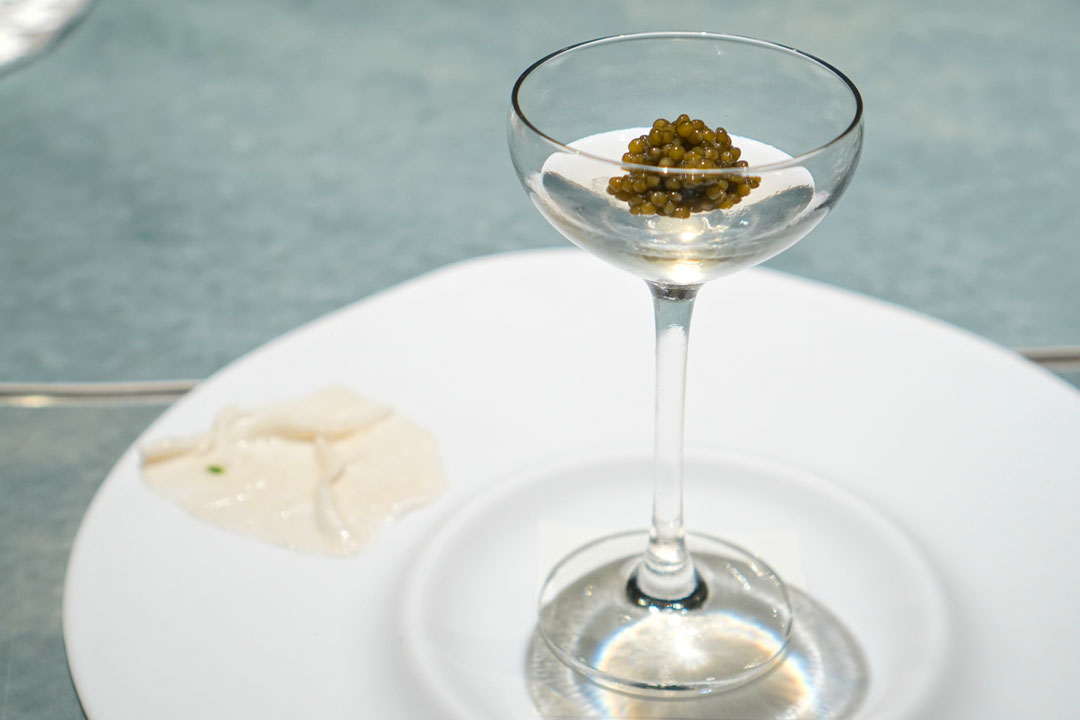
4: Coconut | Green coconut jelly water with Caluga caviar
5: Coconut | Slide of green coconut with ham fat
Green coconut arrived in two ways. I was asked to first consume half the contents of the glass, which comprised a sweet, clean coconut water jelly that was a fantastic counterpoint to the subdued-but-potent brine of Kaluga caviar. Next, I ate the slippery slice of green coconut brushed with ibérico ham fat before going back to the jelly. This was a more intriguing bite, with the saltiness of the jamón working wonders when set over the tropical notes of coco verde. It turns out that ham and coconut is a winning combination--who knew?

6: Sea Urchin | Green mandarin risotto, pumpkin and sea urchin
A tart, refreshing mandarin "risotto" led to the sugariness of oroshigane-grated kabocha and the long-lasting brine of sea urchin, making for a bit of an odd combo, but one that worked out surprisingly well.

7: Sea Urchin | Crunchy fried egg with sea urchin
Next, freeze-dried egg dotted with creamed yolk showcased a toast-like crunch and mouthwatering savor, and really did a great job setting the stage for those soft, sweet, oceany tongues of uni.

8: Cheese | Buffalo Mozzarella Soufflé
This monochromatic course was apparently inspired by the Chef's experience eating fresh mozzarella di bufala in whey, and I think it did a commendable job conveying that sensation. What we had was mozzarella water made into a steamed soufflé, one with an unbelievable lightness and a plethora of sweet, lactic flavors, all leading to a salty finish. This was essentially just cheese, but presented in a multifaceted manner, and represents Adrià's current obsession with utilizing a sole ingredient in sundry ways in one coherent dish.

Leading into the meal's tomato sequence was another bonus bite: a segment of savory-sweet freeze-dried Amela tomato set against a zesty kumquat sorbet.

9: Tomato | Almond soup and tomato soup
Here was a juxtaposition of tomato soup, almond soup, frozen tomato, and frozen almond, punctuated by the saltiness of bottarga. I first tried everything separately, then mixed it all together into a cohesive package. The end result was a perfect marriage of the two main ingredients, rendered in disparate textures and temperatures--a triumph.


10: Anchovy | Cured foie gras in anchovy salt
Salt used in the three-month preservation process of anchovy is typically discarded, but was employed tonight for a seven-minute cure of duck foie gras. The procedure effectively imbued the liver with the saline qualities of the anchoa, providing a fantastic contrast to the offal's rich, luscious nature, and somehow, I even detected this tomato-esque tang in there. It also resulted in a softer, much creamier consistency that I reveled in. This was easily one of the best preparations of foie I've had, and I loved the kitchen's audacity to serve it so brazenly unadorned like this--no distractions, no hiding behind anything.
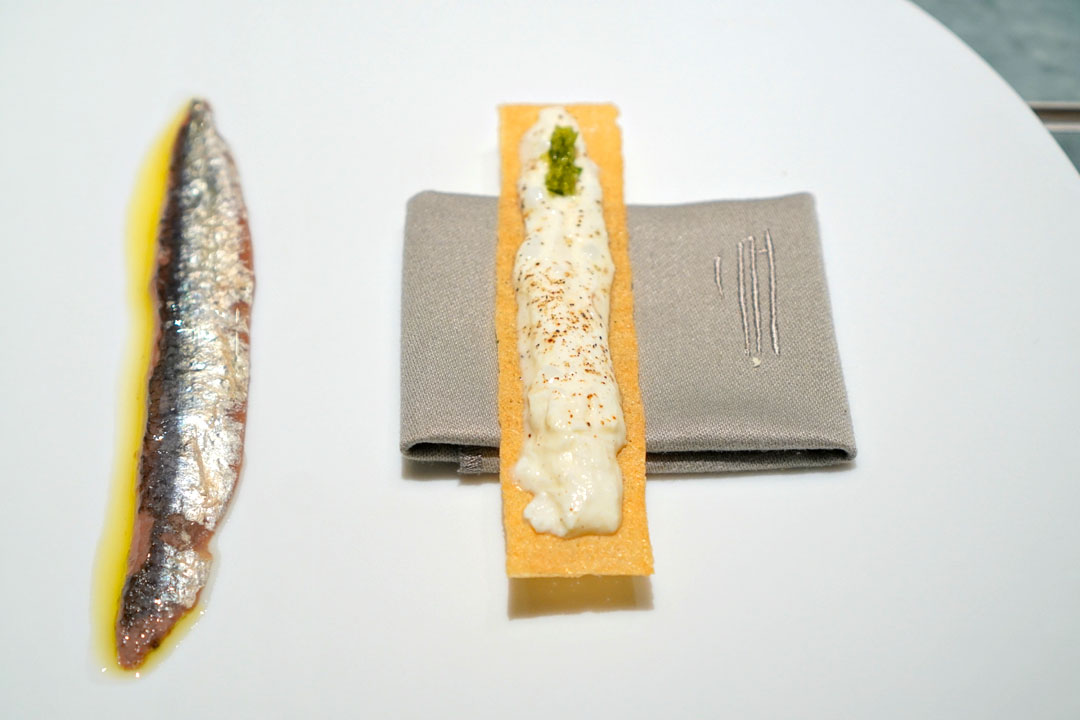

11: Anchovy | Milk skin and anchovy canapé
In this second elaboration of the fish, a "toast" was made with yuba, on top of which was placed fresh cow's milk skin, a mince of parsley and ginger stems, and finally a filet of Cantabrian anchovy. I was smitten by this blissful marriage of unabashedly salty fish and creamy nata, moderated by the greenery and even more so by that crunchy chip. A contender for the best anchovy dish I've had.

12: Mushrooms | Mushrooms and avocado
The mushroom sequence started with a mind-bending course of avocado interspersed with parsley oil-soaked mushrooms, which were remarkably similar to each other. The freshness of the avocado and faux avocado was perked up by pinpricks of spice, while smoked Idiazabal worked wonders for contrast.

13: Mushrooms | Funghi porcini duxelle
Porcini duxelles were set in an aspic made from the same duxelles, then dressed in a sauce made once again with porcini. This was another course that was based almost entirely on one ingredient, and really did convey the nutty, woodsy character of porcini in a clever manner.

14: Mushrooms | Funghi porcini layer
The course above arrived with an ultra-light, sweet-ish crisp made from porcini and layers of obulato, which served as a textural juxtaposition to the duxelles.

15: Mussels | Mussels aspic with frozen onion thai soup
Mussels were given new life thanks to their encasement in mussel aspic, which made for a wonderful mouthfeel, while the brine of the bouchot bivalves was moderated beautifully by the soup's subtle Thai flavors. Very cool.

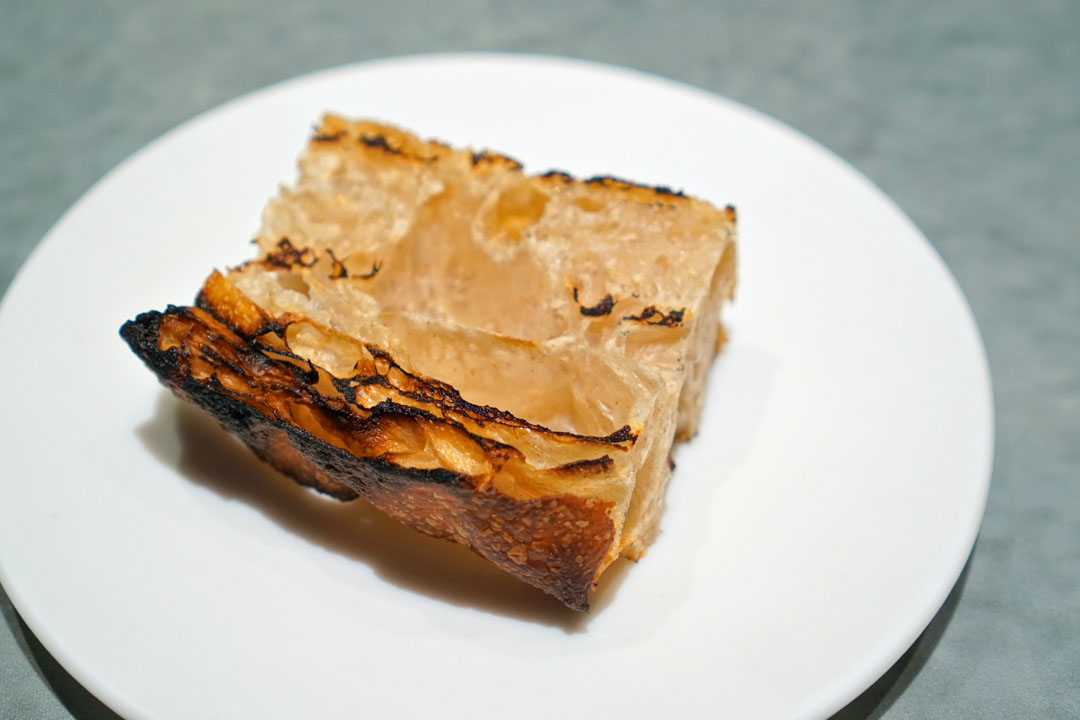
At this point, bread arrived at the table, an amazingly airy, shattery example imbued with a touch of char from being finished in a smoker.

16: Shrimp | Shrimp from Palamós
In easily one of the most memorable dishes of the night, gamba roja was prepared four ways:

17: Sea Cucumber | "Espardeña" inside out
Here, I wasn't told what I was eating ahead of time, but was instead asked to guess by my server. I remarked that it was thus a bit of a mystery, but he likened it to more of an enigma. In any case, I immediately identified this as an espardenya dish, given that I had a traditional preparation at Estimar just a couple days earlier. As delicious as that version was, this was even better, the best sea cucumber I've ever had in fact. I loved the interplay of supple, satisfying textures, as well as all the smoky, oceany flavors at work, tempered by that creamy sauce, while the fried bit offered a wondrously salty crunch.

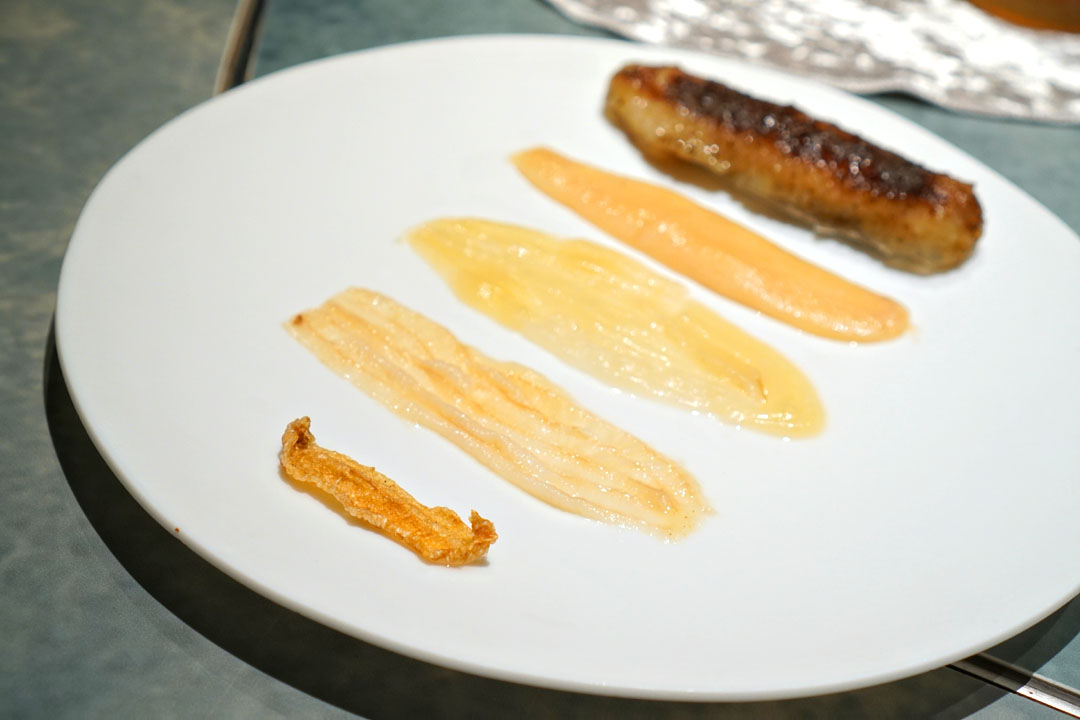
After I was done with the course above, I was offered the explanation of what I just ate. What I had was the entire sea cucumber, deconstructed and assembled back together. The slow-cooked exterior of the animal (the part most often consumed in Chinese cuisine) was prepared and stuffed inside the belly (the espardenya), while a pil pil sauce was made from inner filaments and skin, and a "chicharrón" from more skin. Again, this is the Chef making full use of just one ingredient along with impeccable technique to glorious effect.

18: Veal | Veal cheung fung
Upon tasting this, I was instantly reminded of dim sum, and it turns out that the kitchen's inspiration was indeed cheung fun. However, I actually preferred this to any traditional version of the rice noodle roll I've had. Instead of rice, the wrappers were actually made with thin-sliced cooked veal feet, resulting in a tremendously gratifying mouthfeel. Stuffings included oyster leaf in one and black sausage in the other, while a viscous hot-n-sweet sauce helped tie it all together. Another favorite.

19: Veal | "Osobuco" with caviar
A thoroughly reworked ossobuco featured a delightfully jiggly marrow jelly that forcefully conveyed the essence of the veal, amplified by the punch of smoked caviar. Heavy flavors, but contained in a surprisingly light package.

20: Hare | Kombu ravioli with hare
21: Hare | Hare rib
In my final savory course, wild hare took on two very different forms. A parcel wrapped in kombu was prepared in an OCOO double-pressure cooker, and I was enamored with how the seaweed counterbalanced a hearty filling of hare bolognese, while a hare consommé provided even more oomph. Next to the raviolo was a satisfyingly "bouncy" hare rib meatball, a subtly sweet preparation encased in obulato that was imbued with both an earthiness from the incorporation of foie gras and just enough truffle-fueled musk.
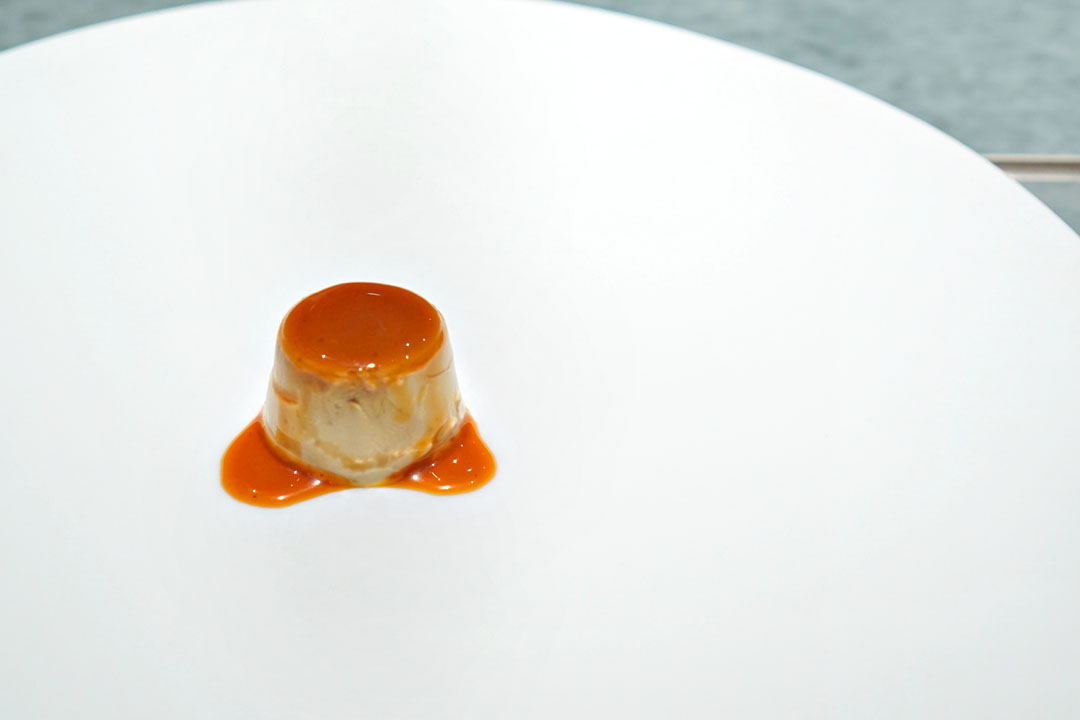
22: Avant Dessert | Foie gras and chicken flan
The first of two transitional courses, this was apparently a reworked version of an El Bulli dish from 1999: a heady foie gras and chicken crème caramel enrobed in a deeply-flavored spider crab caramel(!).

I requested more of the bread from earlier (I probably could've eaten the entire loaf).

23: Avant Dessert | Cheese cake and natural peach
A reinterpreted cheese course was a surprise standout. I began with the confiture of Calanda peach, a super juicy, sugary bite that actually wowed me a bit due to its intensity and focus. Even better, though, was the Valleoscuro, an unexpectedly lightweight, just-funky-enough goat's milk cheese served atop a delightfully puffy cracker.

24: Citrus | Green tangerine shavings with Umami
Produced using a machine gifted to Enigma by Chef Ángel León (of Aponiente in Cádiz), this shaved ice was amazing texturally, while taste-wise, the snow demonstrated boatloads of juicy citrusy flavors beautifully accented by the savor of olive oil.

25: Citrus | Green tangerine and pistachio cake
This one-biter comprised tangerine gel, green pistachio cream, and tangerine zest, all set inside an actual citrus skin. The morsel actually brought things back to the savory side for just a bit, which I appreciated.

With the Selosse above all drunk up, I was still thirsty, and thus asked to see the cocktail list, the creation of Head Bartender Ofelia Otalvano. Click for a larger version.

Kumquat [20.00€ ($21.74)] | Kumquat juice, Hibiki Japanese Harmony, bitter chocolate and Dolin dry vermouth
My first cocktail displayed a nose of bright, tart citrus, with just a hint of cacao peeking through. Taking a sip, I got the signature smack of the Japanese whisky right up front, supported by more kumquat and palpably dry notes of dusty chocolate.

26: Citrus | Custard apple
Creamy cuts of cherimoya revealed a tropical, multiplex sweetness evened out by both a bracingly tart lemon skin sorbet and a rich, lactic commixture of yogurt and olive oil.

27: Citrus | Chestnut, sweet potato and sudachi
A mini-quenelle of vibrant sweet potato sorbet was crowned with sudachi zest, and sat atop a fascinatingly-textured, familiarly-flavored chestnut crisp.

In this super smart rendition of the ubiquitous Basque cheesecake, a smoky, charred outer layer encased a delectably sweet-n-creamy tarta de queso filling, making for the most perfect bite of cheesecake ever. Another bonus off-menu treat.
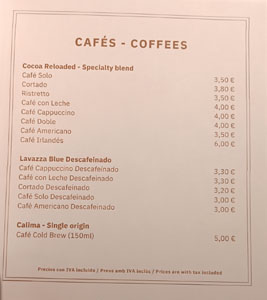

My cocktail now finished, I requested Enigma's coffee list. Click for larger versions.
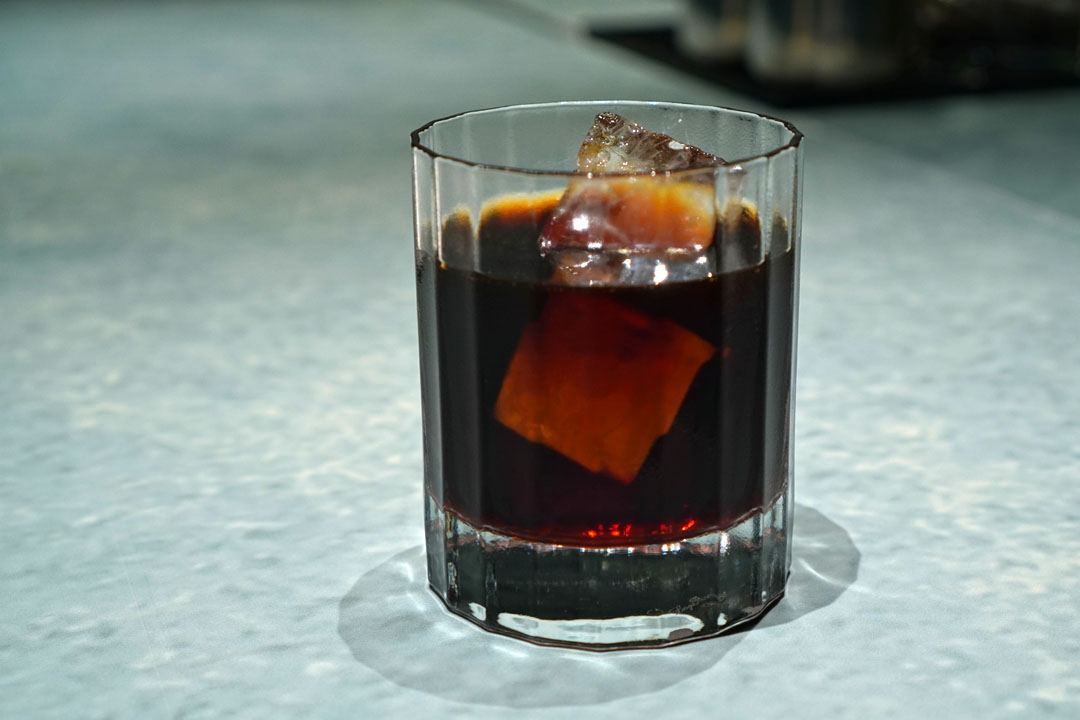
I ended up going with the Calima - Single origin Café Cold Brew [5.00€ ($5.44)]. The bouquet here expressed a lovely roastiness commingled with traces of bell pepper. On the palate, the coffee was silky smooth, its roasty, smoky characteristics tinged by hints of tropical fruit.
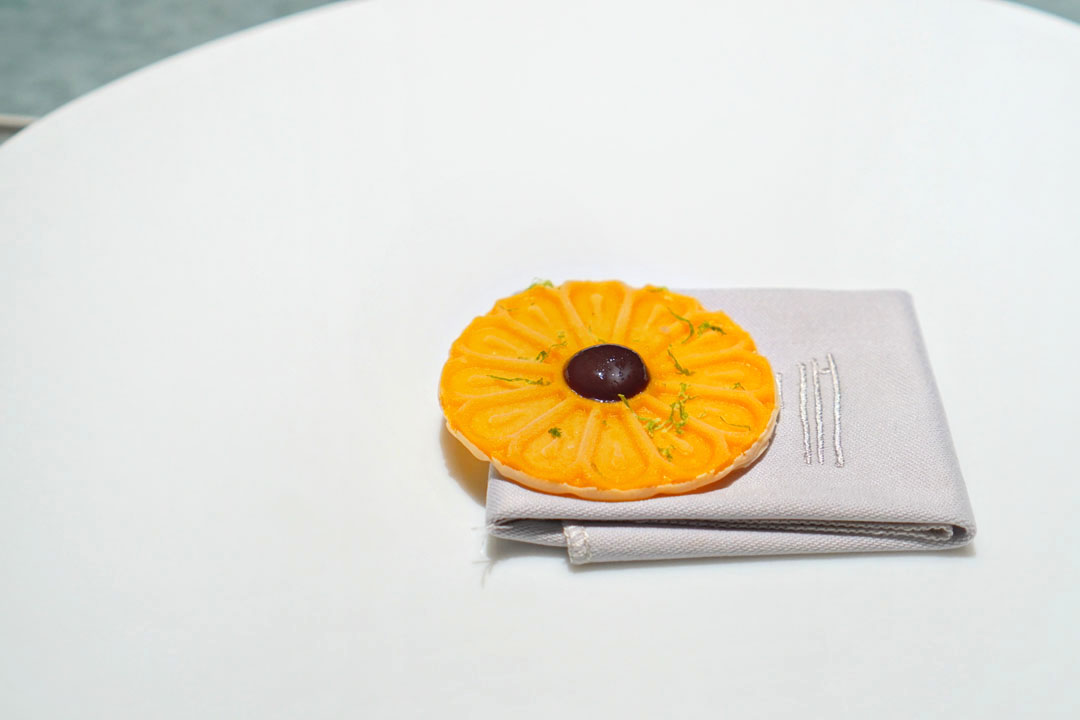
28: Chocolate | Mango with white chocolate and black olive caramel
Here we had a modernized version of an El Bulli dessert from 1997, consisting of a nitro Alphonso mango gel set over a white chocolate disk, with a black olive caramel center. I was a huge fan of the interaction between that sugary mango and piquant olive--an astute pairing indeed.

29: Chocolate | Cocoa waffle with tonka bean
A multipronged presentation of chocolate brought together crispy cocoa waffle, fragrant tonka, and a Valrhona Guanaja 70% parfait, making for a cohesive two-biter with welcomed contrasts in both texture and temperature.

Figa [15.00€ ($16.31)] | Fig water, hibiscus, Tio Pepe Una palma sherry wine, umeshu and lime juice
I had room for one final cocktail, and went with this low-ABV number, which evinced the nutty, saline depth of jerez alongside this almost foie gras-like quality.


Along with the bill came a take-home version of the night's menu as well as an Effervescent menthol and lime candy, which I ate a few days later: think subtly sour and lingeringly minty, with a slight effervescence.




Here we see the menu, signed by the Chef, as well as cards listing the staff's favorite bars and restaurants in Barcelona. And if you're curious about that QR code, it links to this web site describing more details of tonight's degustation. Click for larger versions.
Well this was just a spellbinder of a dining experience. Enigma strikes me as an evolution, or perhaps reenvisioning of El Bulli to fit the current culinary zeitgeist, which I suppose isn't too surprising given the crucial role that Adrià played in defining that restaurant. The techno-emotional cuisine he helped develop in Roses has been given what I'll call a "minimalist" makeover. There's a quiet confidence, a sense of maturity in the cooking, and though the food may present itself as spare or even austere at times, it's also very often focused, cerebral, profound--a manifestation of the mantra "less is more." Technique, although omnipresent, has seemingly been deemphasized in favor of purity and essence, a trend probably best witnessed in the Chef's experiments in building dishes with essentially just one ingredient. Previously, I deemed Disfrutar as my top meal of 2024, but with this effort, I think Adrià and his team may have just edged them out.

Carrer de Sepúlveda, 38, 40, L'Eixample, 08015 Barcelona, Spain
+34 932 20 19 74
www.enigmaconcept.es
Mon 10/21/2024, 07:00p-11:05p

On my final day in Barcelona, I finally made my way over to Enigma, no doubt one of the poster children of avant garde Spanish cookery. And why wouldn't it be? The place is the invention of none other than Albert Adrià, of elBulli fame, and represents the closest that we'll likely ever get to a contemporary interpretation of that legendary restaurant in Roses. This was definitely a high priority visit for me.
About the Chef: Albert Adrià Acosta was born in October 1969 in L'Hospitalet de Llobregat, Barcelona, the son of parents Ginés and Josefa. Inspired by his older brother Ferran Adrià, he decided to pursue a career in food in 1985, and began apprenticing at El Bulli, where Ferran was already working. After two years, he committed himself to heading up the pastry department at the restaurant, and during winter closures, he furthered his training at the likes of Pastisseria Turull in Terrassa, Pastisseria Escribà in Barcelona, and Pastelería Totel in Elda, under Francisco Torreblanca. He even staged at Guy Savoy for six weeks, following completion of his military service in 1988. In 1990, El Bulli regained two Michelin stars, which it lost in 1985 following the departure of Jean-Paul Vinay, who initially secured the honor in '83. Three stars arrived in 1997, but it was also during this time when Adrià left the restaurant to write his first book: Los Postres de elBulli, published in October 1998.
Following, he rejoined El Bulli in late '98, this time in the creativity workshop (taller), teaming up with Oriol Castro and eventually taking over the operation altogether. In 2002, El Bulli topped the World's 50 Best Restaurants list for the first time, a feat repeated consecutively from 2006 to 2009. Throughout these years, Adrià also expanded his knowledge by working stints at Bras, The Fat Duck, Mugaritz, Martín Berasategui, and even Charlie Trotter's. In March 2006, he teamed up with childhood friend Juan Martínez to launch the tapas-focused Inopia Classic Bar in Barcelona, and actually ended up leaving El Bulli in 2008. However, the Chef sold his stake in Inopia in July 2010, and it would eventually turn into Lolita Tapería.
Adrià instead decided to link up with the Iglesias brothers (Juan Carlos, Borja, and Pedro, of Rías de Galicia) as well as Ferran to start a series of restaurants in the Sant Antoni neighborhood under the elBarri banner. First up were 41º and Tickets, which dropped in early 2011. The former was a cocktail bar that eventually turned into a tasting menu place referred to as the 41º Experience, while the latter was a thoroughly reimagined tapas joint. They were followed in 2013 by Patka, a Peruvian-Japanese fusion eatery. In September that year, vermouth bar Bodega 1900 opened, while in November, both Tickets and 41º were Michelin-starred. 2014 saw the dual debuts of taco spot Niño Viejo and the higher-end Mexican eatery Hoja Santa, in collaboration with Paco Méndez, though Niño Viejo would close in 2019 to make way for the expansion of Hoja Santa (which got Michelin-starred in November '15).
Meanwhile, 41 Degrees shuttered in August 2014, its space taken over by Tickets, and in November, Patka received its own Michelin star. In February 2015, Adrià and his brother teamed up with Cirque du Soleil's Guy Laliberté for Heart Ibiza, with the goal of merging together the worlds of gastronomy and art, though the venue shut down during the pandemic. The Chef started his residency at the Hotel Café Royal in London in February 2016, which was followed by the opening of Cakes & Bubbles pastry shop at the hotel in 2018. Enigma launched in January 2017 as an evolution of 41º, and received a star from Michelin in November that year. In March 2019, Mercado Little Spain food hall opened in New York; this was a project spearheaded by José Andrés, with the Adriàs serving as consultants. In June 2019, Enigma made it on to The World's 50 Best Restaurants ranking at #82 (up from #95 the previous year), while Tickets was #20.
Sadly, the pandemic marked the end of the El Barri group, as every restaurant in the company ended up shutting down except for Enigma, which apparently was under a different ownership structure. Adrià did remain active during COVID-19 though, and in November 2021, he participated in the ADMO project, a pop-up led by Alain Ducasse located at Les Ombres in Paris, adjacent to the Eiffel Tower. June 2022 saw the birth of Enigma 2.0, a reinvention of the restaurant that did away with much of the fanciness behind the place. In fact, the team even started off with à la carte ordering, though they did eventually switch back to a tasting menu, albeit with a pared down overall experience. Enigma regained its Michelin star in November that year, and in June 2023, landed on The World's 50 Best list at #82 (again), which improved to #59 in June 2024. Most recently, in July, Adrià, in concert with Alfredo Machado, opened Gelato Collection in Barcelona, which aims to apply the rigor of Enigma to an ice cream parlor.

Upon entering, it's quickly evident that this isn't an ordinary restaurant.

The entry hallway leads to a waiting area.

Here we see the RCR Arquitectes-penned dining room, easily one of the most striking I've ever encountered. Of particular note are the cloud-inspired ceilings and translucent walls, which result in a dreamy sort of feel that make this place absolutely one-of-a-kind.


Given that I was a solo diner (which was allowed by special request), I was seated by myself at the bar.



I was soon presented with the night's menu, a roughly 30-course affair priced at a reasonable 240€ ($260.90) a head. The Spanish Tour wine pairing tacks on an additional 100€ ($108.71), while the Old World Wines pairing is 165€ ($179.37). There's also a very respectable wine list, which boasts a particular strength in the area of Champagne. Click for larger versions.

1: Mezcal | Pomegranate tepache and mezcal
Dinner commenced with a tepache that incorporated pomegranate instead of the usual pineapple, and also included what I believe was a pechuga-style mezcal. Smoky, tart, and vegetal, this certainly awakened the palate.

2: Mezcal | Lime porex
I was instructed to taste back-and-forth between the tepache above and this impossibly light, airy, tart-yet-savory "porex" composed of inulin lime cream, lime zest, and young espadín mezcal.

3: Mezcal | Mezcalita frozen cloud
Next up was a whipped and frozen "cloud" made with mezcal, lime, and lime zest. It went in a similar direction as the previous bite, but was even more bracing and refreshing and invigorating, with a stark temperature contrast to boot.

This last welcome snack was a bonus, and consisted of a super shattery, sweet, lingeringly savory roselle (hibiscus) chip with Iranian green pistachio.

To pair with my dinner, I went with the Jacques Selosse "Brut Rosé" Brut, NV [420€ ($456.58)] (disgorged May 6th, 2021). Throughout this trip, I've been drinking almost exclusively local wine, but felt compelled to order the Selosse given its very appealing pricing, as a bottle of this usually retails for around $800 in the US. The vibrantly orange-hued Champagne was definitely not like your typical rosé, but instead acted more along the lines of a substantial white wine. The nose was super oxidized, with a palpably nutty, funky, yeasty quality, while the palate leaned dry and savory, with more of that oxidative character. As the juice warmed, things became even nuttier, even more dark-toned. However, further time brought a much fruitier bouquet, with a deep, concentrated dosing of apricot preserves; this was joined by a softer flavor profile, with loads of orchard fruits cut by a pert acidity, the nuttiness still present, but more in the background. At the conclusion of the night, the bubbly was super rich and dense in terms of aroma, with its tertiary-style qualities on full display, while the palate got noticeably thicker, and exhibited this soft spiciness. The evolution of the sparkling wine over the course of a few hours was pretty remarkable, and I'm super glad that I got to try this at such a good price!

4: Coconut | Green coconut jelly water with Caluga caviar
5: Coconut | Slide of green coconut with ham fat
Green coconut arrived in two ways. I was asked to first consume half the contents of the glass, which comprised a sweet, clean coconut water jelly that was a fantastic counterpoint to the subdued-but-potent brine of Kaluga caviar. Next, I ate the slippery slice of green coconut brushed with ibérico ham fat before going back to the jelly. This was a more intriguing bite, with the saltiness of the jamón working wonders when set over the tropical notes of coco verde. It turns out that ham and coconut is a winning combination--who knew?

6: Sea Urchin | Green mandarin risotto, pumpkin and sea urchin
A tart, refreshing mandarin "risotto" led to the sugariness of oroshigane-grated kabocha and the long-lasting brine of sea urchin, making for a bit of an odd combo, but one that worked out surprisingly well.

7: Sea Urchin | Crunchy fried egg with sea urchin
Next, freeze-dried egg dotted with creamed yolk showcased a toast-like crunch and mouthwatering savor, and really did a great job setting the stage for those soft, sweet, oceany tongues of uni.

8: Cheese | Buffalo Mozzarella Soufflé
This monochromatic course was apparently inspired by the Chef's experience eating fresh mozzarella di bufala in whey, and I think it did a commendable job conveying that sensation. What we had was mozzarella water made into a steamed soufflé, one with an unbelievable lightness and a plethora of sweet, lactic flavors, all leading to a salty finish. This was essentially just cheese, but presented in a multifaceted manner, and represents Adrià's current obsession with utilizing a sole ingredient in sundry ways in one coherent dish.

Leading into the meal's tomato sequence was another bonus bite: a segment of savory-sweet freeze-dried Amela tomato set against a zesty kumquat sorbet.

9: Tomato | Almond soup and tomato soup
Here was a juxtaposition of tomato soup, almond soup, frozen tomato, and frozen almond, punctuated by the saltiness of bottarga. I first tried everything separately, then mixed it all together into a cohesive package. The end result was a perfect marriage of the two main ingredients, rendered in disparate textures and temperatures--a triumph.


10: Anchovy | Cured foie gras in anchovy salt
Salt used in the three-month preservation process of anchovy is typically discarded, but was employed tonight for a seven-minute cure of duck foie gras. The procedure effectively imbued the liver with the saline qualities of the anchoa, providing a fantastic contrast to the offal's rich, luscious nature, and somehow, I even detected this tomato-esque tang in there. It also resulted in a softer, much creamier consistency that I reveled in. This was easily one of the best preparations of foie I've had, and I loved the kitchen's audacity to serve it so brazenly unadorned like this--no distractions, no hiding behind anything.


11: Anchovy | Milk skin and anchovy canapé
In this second elaboration of the fish, a "toast" was made with yuba, on top of which was placed fresh cow's milk skin, a mince of parsley and ginger stems, and finally a filet of Cantabrian anchovy. I was smitten by this blissful marriage of unabashedly salty fish and creamy nata, moderated by the greenery and even more so by that crunchy chip. A contender for the best anchovy dish I've had.

12: Mushrooms | Mushrooms and avocado
The mushroom sequence started with a mind-bending course of avocado interspersed with parsley oil-soaked mushrooms, which were remarkably similar to each other. The freshness of the avocado and faux avocado was perked up by pinpricks of spice, while smoked Idiazabal worked wonders for contrast.

13: Mushrooms | Funghi porcini duxelle
Porcini duxelles were set in an aspic made from the same duxelles, then dressed in a sauce made once again with porcini. This was another course that was based almost entirely on one ingredient, and really did convey the nutty, woodsy character of porcini in a clever manner.

14: Mushrooms | Funghi porcini layer
The course above arrived with an ultra-light, sweet-ish crisp made from porcini and layers of obulato, which served as a textural juxtaposition to the duxelles.

15: Mussels | Mussels aspic with frozen onion thai soup
Mussels were given new life thanks to their encasement in mussel aspic, which made for a wonderful mouthfeel, while the brine of the bouchot bivalves was moderated beautifully by the soup's subtle Thai flavors. Very cool.


At this point, bread arrived at the table, an amazingly airy, shattery example imbued with a touch of char from being finished in a smoker.

16: Shrimp | Shrimp from Palamós
In easily one of the most memorable dishes of the night, gamba roja was prepared four ways:
- Starting from the bottom, we have a six-month-old red prawn, served raw, which had an agreeably supple consistency and really took well to the savory, salty nature of its fried shrimp head-tasting sauce.
- Next, a gamba rosada up to one-and-a-half years-old was marinated in lime, making for a stickier texture and a citrusy zing.
- A three-year prawn arrived cured with salt, and showed off an overt brine and an even stickier mouthfeel.
- Lastly, a shrimp in the range of three- to four years-old was boiled, giving it a familiar consistency and a more assertive taste.

17: Sea Cucumber | "Espardeña" inside out
Here, I wasn't told what I was eating ahead of time, but was instead asked to guess by my server. I remarked that it was thus a bit of a mystery, but he likened it to more of an enigma. In any case, I immediately identified this as an espardenya dish, given that I had a traditional preparation at Estimar just a couple days earlier. As delicious as that version was, this was even better, the best sea cucumber I've ever had in fact. I loved the interplay of supple, satisfying textures, as well as all the smoky, oceany flavors at work, tempered by that creamy sauce, while the fried bit offered a wondrously salty crunch.


After I was done with the course above, I was offered the explanation of what I just ate. What I had was the entire sea cucumber, deconstructed and assembled back together. The slow-cooked exterior of the animal (the part most often consumed in Chinese cuisine) was prepared and stuffed inside the belly (the espardenya), while a pil pil sauce was made from inner filaments and skin, and a "chicharrón" from more skin. Again, this is the Chef making full use of just one ingredient along with impeccable technique to glorious effect.

18: Veal | Veal cheung fung
Upon tasting this, I was instantly reminded of dim sum, and it turns out that the kitchen's inspiration was indeed cheung fun. However, I actually preferred this to any traditional version of the rice noodle roll I've had. Instead of rice, the wrappers were actually made with thin-sliced cooked veal feet, resulting in a tremendously gratifying mouthfeel. Stuffings included oyster leaf in one and black sausage in the other, while a viscous hot-n-sweet sauce helped tie it all together. Another favorite.

19: Veal | "Osobuco" with caviar
A thoroughly reworked ossobuco featured a delightfully jiggly marrow jelly that forcefully conveyed the essence of the veal, amplified by the punch of smoked caviar. Heavy flavors, but contained in a surprisingly light package.

20: Hare | Kombu ravioli with hare
21: Hare | Hare rib
In my final savory course, wild hare took on two very different forms. A parcel wrapped in kombu was prepared in an OCOO double-pressure cooker, and I was enamored with how the seaweed counterbalanced a hearty filling of hare bolognese, while a hare consommé provided even more oomph. Next to the raviolo was a satisfyingly "bouncy" hare rib meatball, a subtly sweet preparation encased in obulato that was imbued with both an earthiness from the incorporation of foie gras and just enough truffle-fueled musk.

22: Avant Dessert | Foie gras and chicken flan
The first of two transitional courses, this was apparently a reworked version of an El Bulli dish from 1999: a heady foie gras and chicken crème caramel enrobed in a deeply-flavored spider crab caramel(!).

I requested more of the bread from earlier (I probably could've eaten the entire loaf).

23: Avant Dessert | Cheese cake and natural peach
A reinterpreted cheese course was a surprise standout. I began with the confiture of Calanda peach, a super juicy, sugary bite that actually wowed me a bit due to its intensity and focus. Even better, though, was the Valleoscuro, an unexpectedly lightweight, just-funky-enough goat's milk cheese served atop a delightfully puffy cracker.

24: Citrus | Green tangerine shavings with Umami
Produced using a machine gifted to Enigma by Chef Ángel León (of Aponiente in Cádiz), this shaved ice was amazing texturally, while taste-wise, the snow demonstrated boatloads of juicy citrusy flavors beautifully accented by the savor of olive oil.

25: Citrus | Green tangerine and pistachio cake
This one-biter comprised tangerine gel, green pistachio cream, and tangerine zest, all set inside an actual citrus skin. The morsel actually brought things back to the savory side for just a bit, which I appreciated.

With the Selosse above all drunk up, I was still thirsty, and thus asked to see the cocktail list, the creation of Head Bartender Ofelia Otalvano. Click for a larger version.

Kumquat [20.00€ ($21.74)] | Kumquat juice, Hibiki Japanese Harmony, bitter chocolate and Dolin dry vermouth
My first cocktail displayed a nose of bright, tart citrus, with just a hint of cacao peeking through. Taking a sip, I got the signature smack of the Japanese whisky right up front, supported by more kumquat and palpably dry notes of dusty chocolate.

26: Citrus | Custard apple
Creamy cuts of cherimoya revealed a tropical, multiplex sweetness evened out by both a bracingly tart lemon skin sorbet and a rich, lactic commixture of yogurt and olive oil.

27: Citrus | Chestnut, sweet potato and sudachi
A mini-quenelle of vibrant sweet potato sorbet was crowned with sudachi zest, and sat atop a fascinatingly-textured, familiarly-flavored chestnut crisp.

In this super smart rendition of the ubiquitous Basque cheesecake, a smoky, charred outer layer encased a delectably sweet-n-creamy tarta de queso filling, making for the most perfect bite of cheesecake ever. Another bonus off-menu treat.


My cocktail now finished, I requested Enigma's coffee list. Click for larger versions.

I ended up going with the Calima - Single origin Café Cold Brew [5.00€ ($5.44)]. The bouquet here expressed a lovely roastiness commingled with traces of bell pepper. On the palate, the coffee was silky smooth, its roasty, smoky characteristics tinged by hints of tropical fruit.

28: Chocolate | Mango with white chocolate and black olive caramel
Here we had a modernized version of an El Bulli dessert from 1997, consisting of a nitro Alphonso mango gel set over a white chocolate disk, with a black olive caramel center. I was a huge fan of the interaction between that sugary mango and piquant olive--an astute pairing indeed.

29: Chocolate | Cocoa waffle with tonka bean
A multipronged presentation of chocolate brought together crispy cocoa waffle, fragrant tonka, and a Valrhona Guanaja 70% parfait, making for a cohesive two-biter with welcomed contrasts in both texture and temperature.

Figa [15.00€ ($16.31)] | Fig water, hibiscus, Tio Pepe Una palma sherry wine, umeshu and lime juice
I had room for one final cocktail, and went with this low-ABV number, which evinced the nutty, saline depth of jerez alongside this almost foie gras-like quality.


Along with the bill came a take-home version of the night's menu as well as an Effervescent menthol and lime candy, which I ate a few days later: think subtly sour and lingeringly minty, with a slight effervescence.




Here we see the menu, signed by the Chef, as well as cards listing the staff's favorite bars and restaurants in Barcelona. And if you're curious about that QR code, it links to this web site describing more details of tonight's degustation. Click for larger versions.
Well this was just a spellbinder of a dining experience. Enigma strikes me as an evolution, or perhaps reenvisioning of El Bulli to fit the current culinary zeitgeist, which I suppose isn't too surprising given the crucial role that Adrià played in defining that restaurant. The techno-emotional cuisine he helped develop in Roses has been given what I'll call a "minimalist" makeover. There's a quiet confidence, a sense of maturity in the cooking, and though the food may present itself as spare or even austere at times, it's also very often focused, cerebral, profound--a manifestation of the mantra "less is more." Technique, although omnipresent, has seemingly been deemphasized in favor of purity and essence, a trend probably best witnessed in the Chef's experiments in building dishes with essentially just one ingredient. Previously, I deemed Disfrutar as my top meal of 2024, but with this effort, I think Adrià and his team may have just edged them out.

1 Comments:
Merry Christmas Kevin! Hopefully you have some time off and get to relax.
Post a Comment
Subscribe to Post Comments [Atom]
<< Home